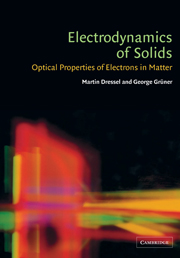1 - Introduction
Published online by Cambridge University Press: 20 May 2010
Summary
Ever since Euclid, the interaction of light with matter has aroused interest – at least among poets, painters, and physicists. This interest stems not so much from our curiosity about materials themselves, but rather to applications, should it be the exploration of distant stars, the burning of ships of ill intent, or the discovery of new paint pigments.
It was only with the advent of solid state physics about a century ago that this interaction was used to explore the properties of materials in depth. As in the field of atomic physics, in a short period of time optics has advanced to become a major tool of condensed matter physics in achieving this goal, with distinct advantages – and some disadvantages as well – when compared with other experimental tools.
The focus of this book is on optical spectroscopy, defined here as the information gained from the absorption, reflection, or transmission of electromagnetic radiation, including models which account for, or interpret, the experimental results. Together with other spectroscopic tools, notably photoelectron and electron energy loss spectroscopy, and Raman together with Brillouin scattering, optics primarily measures charge excitations, and, because of the speed of light exceeding substantially the velocities of various excitations in solids, explores in most cases the Δq = 0 limit. While this is a disadvantage, it is amply compensated for by the enormous spectral range which can be explored; this range extends from well below to well above the energies of various single-particle and collective excitations.
Information
- Type
- Chapter
- Information
- Electrodynamics of SolidsOptical Properties of Electrons in Matter, pp. 1 - 6Publisher: Cambridge University PressPrint publication year: 2002
Accessibility standard: Unknown
Why this information is here
This section outlines the accessibility features of this content - including support for screen readers, full keyboard navigation and high-contrast display options. This may not be relevant for you.Accessibility Information
- 1
- Cited by
